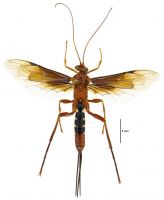ICHNEUMONIDAE: : Ctenochares Förster 1869
Diagnosis:
Ctenochares is easily recognized by the colouration of its forewings, with large black tips.Characteristics of Ctenochares include: 1. Body size 10-20mm; 2. Position of spiracle on T1 clearly behind the centre; 3. Shape of aerolet in forewing is pentagonal (closed); 4. Colour of face not all black; 5. Metasoma compressed dorsal-ventrally; 6. Size of ocelli are small; 7. Length of antennae is shorter than body; 8. Length of ovipositor is barely visible; 9. Wings present; 10. Colour of wings are mostly clear but with dark patches/spots at the tips; 11. Sternaulus (on mesopleuron) absent; 12. Shape of face in lateral view is flat or only weakly bulging; 13. Sternite on T1(viewed laterally) not extending past spiracle; 14. Shape of T1 (viewed laterally) is evenly curved; 15. Number of teeth in mandibles 2; 16. Metasoma bicoloured (orange and black); 17. Length of T1 vs T2 subequal in length; 18. Sculpture on mesoscutum is finely pitted, many hairs; 19. Width of T1 (viewed dorsally) anterior part slender often parallel, strongly widening behind spiracle; 20. Glymma on T1 absent; 21. Sculpture on metasoma is smooth with a semi-glossy or satin appearance at least on T2; 22. Propodeum reaching past coxal insertion, but not reaching halfway along metacoxae.
Similarity to Other Taxa
Ctenochares is easily recognized by the black tips of its forewings.Ctenochares is a large-sized Ichneumonid in New Zealand. It is similar in size to: Rhyssa , Lissopimpla , Echthromorpha , Ophion (1 species), Enicospilus , Eutanyacra , Ichneumon , Netelia , Xanthocryptus , and Degithina .
Compare
-

Lissopimpla
Also has distinct (but different) colourations in the forewing, but Ctenochares has the spiracle on T1 well behind the centre. -

Echthromorpha
Also has distinct (but different) colourations in the forewing, but Ctenochares has the spiracle on T1 well behind the centre. -

Enicospilus
Ctenochares does not have large distinct ocelli. -

Ophion
Ctenochares does not have large distinct ocelli. -

Netelia
Ctenochares does not have large distinct ocelli. -

Degithina
T1 humped (bulge), Ctenochares is evenly curved. -

Eutanyacra
Does not have forewings with black tips. -

Ichneumon
Does not have forewings with black tips. -

Rhyssa
Has spots on the metasoma not stripes, and the oviposiotr in Rhyssa is as long(er) than the body. -

Xanthocryptus
Has distinct black and white stripes on the metasoma.
Distribution in NZ
North Island: AK, HB.
Species in NZ
One species: Ctenochares bicolorus (Linnaeus, 1767).Biology & hosts
Ctenochares is primarily an African genus with 10 described species mostly found in savannah habitats (Gauld 1984). One species, C. bicolorus , is recorded from Africa and southern Europe around the Mediterranean. It was first in Australia in the 1970s and in New Zealand in 1981.In New Zealand Ctenochares bicolorus has been recorded from the Green Garden Looper, Chrysodeixis eriosoma (Noctuidae), and overseas from Chrysodeixis chalcites and Spodoptera litura (both Noctuidae) (Yu et al 2005).
Sources of information
Gauld ID. 1984. An Introduction to the Ichneumonidae of Australia. London, British Museum (Natural History). 413 p.Valentine EW & Walker AK. 1991. Annotated Catalogue of New Zealand Hymenoptera. DSIR Plant Protection Report 4. General Printing Services, 84 p.
Yu DS, van Achterburg K, Horstmann K. 2005. World Ichneumonoidea 2004. Taxonomy, Biology, Morphology and Distribution. CD/DVD. Taxapad. Vancouver, Canada.
Citation
Ward DF & Schnitzler FR. 2013. Ichneumonidae of New Zealand. Genus Ctenochares http://ichneumonidae.landcareresearch.co.nzAccessed: 10 March 2025


